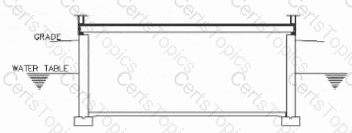The diagram shows a basement foundation wall below the water table. During heavy rains, the water table can rise, increasing hydrostatic pressure against foundation walls and under the slab.
Key concern:
While lateral water pressure against the walls is a factor, the question specifies "also a major concern". In this scenario, the water pressure beneath the slab can cause buoyant uplift — vertical upward pressure — known as hydrostatic uplift or floatation.
If this upward force exceeds the weight of the slab and the structure above, it can cause the slab to crack, lift, or fail — especially if there is no adequate under-slab drainage or tiedown anchors.
Why not the other options:
A. Moisture absorption of the concrete foundation wall — Concrete is porous, but waterproofing and drainage address this; not as critical in terms of structural threat as uplift.
B. Increased weight on the footings — Hydrostatic pressure acts laterally and upward; it does not significantly increase vertical load on footings in the same way dead load does.
D. Differential lateral pressure on total building structure — Lateral pressure affects the foundation walls, but "total building structure" is less directly impacted than the immediate risk to the slab from uplift.
NCARB PDD References:
ARE 5.0 Handbook — PDD Section: Site conditions and foundation systems
IBC 2018 Section 1805.4 — Waterproofing and drainage
Foundation Engineering principles — Hydrostatic uplift and buoyancy
NCARB PDD Study Guide Topic: Subsurface water control (sumps, drain tiles, hydrostatic relief)
